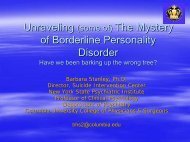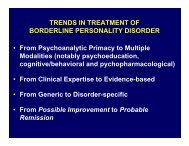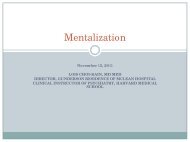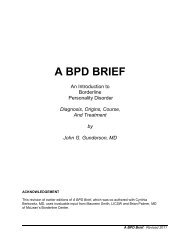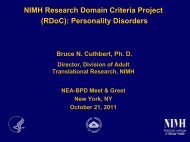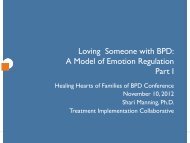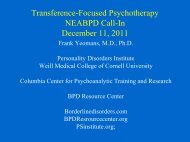John Oldham - Borderline Personality Disorder
John Oldham - Borderline Personality Disorder
John Oldham - Borderline Personality Disorder
Create successful ePaper yourself
Turn your PDF publications into a flip-book with our unique Google optimized e-Paper software.
Stigma and <strong>Borderline</strong> <strong>Personality</strong><br />
<strong>Disorder</strong><br />
Federal Partners Meeting on <strong>Borderline</strong> <strong>Personality</strong> <strong>Disorder</strong><br />
Co-sponsored by National Alliance on Mental Illness &<br />
National Educational Alliance for BPD<br />
Rockville, MD – November 9, 2011<br />
<strong>John</strong> M. <strong>Oldham</strong>, MD, MS<br />
Senior Vice President and Chief of Staff<br />
The Menninger Clinic<br />
Professor and Executive Vice Chair<br />
Menninger Department of Psychiatry and Behavioral Sciences<br />
Baylor College of Medicine<br />
President, American Psychiatric Association
<strong>Personality</strong> “Order” or “<strong>Disorder</strong>”<br />
Q Since everyone has a personality, how<br />
do we decide what a personality disorder<br />
is<br />
A Having too much or too little of normal<br />
traits can cause problems in functioning<br />
(like high blood pressure or low blood<br />
pressure).
DSM-IV Definition of <strong>Personality</strong> <strong>Disorder</strong><br />
An enduring pattern of inner experience and<br />
behavior that deviates markedly from the<br />
expectations of the individual’s culture. This<br />
pattern is manifested in two (or more) of the<br />
following areas:<br />
1. Cognition<br />
2. Emotions<br />
3. Interpersonal functioning<br />
4. Impulse control
<strong>Borderline</strong> <strong>Personality</strong> <strong>Disorder</strong> (BPD)<br />
APA DSM-IV Criteria<br />
(At least 5 must be present)<br />
1. Fear of abandonment<br />
2. Difficult interpersonal relationships<br />
3. Uncertainty about self-image or identity<br />
4. Impulsive behavior<br />
5. Self-injurious behavior<br />
6. Emotional changeability or hyperactivity<br />
7. Feelings of emptiness<br />
8. Difficulty controlling intense anger<br />
9. Transient suspiciousness or “disconnectedness”
Prevalence of <strong>Borderline</strong> <strong>Personality</strong><br />
<strong>Disorder</strong><br />
• General population 5.9%*<br />
• Mental health outpatient 11%<br />
• Mental health inpatient 19%<br />
• Primary care 6%<br />
* Grant B, J Clin Psychiatry, 2008
Comorbidity<br />
• 84.5% of BPD patients met criteria for Axis I<br />
disorder, mean = 3.2<br />
• Most common =<br />
• Mood disorders<br />
• Anxiety disorders<br />
• Substance use disorders<br />
- Lenzenweger et al., Biol Psychiatry, 2007
Patients with BPD Have<br />
Severe Impairment in Functioning<br />
• Common history of childhood trauma<br />
• Mistrustful of others, yet cling to others for<br />
“life support”<br />
• High internal levels of anxiety and distress<br />
• Stormy interpersonal relationships<br />
• High family stress<br />
• Difficulty keeping jobs<br />
• Overemotional and impulsive<br />
• Self-injurious behavior
High Suicide Risk in Patients with BPD<br />
8 – 10 % commit suicide<br />
60 – 70 % make suicide attempts
Worldwide Magnitude of Psychiatric<br />
Disability
The Global Burden of Disease<br />
Results: The Unseen Burden of Psychiatric Disease<br />
“Most significantly, the study shows that the burden of<br />
psychiatric conditions has been heavily underestimated. Of the<br />
ten leading causes of disability worldwide in 1990, measured in<br />
years lived with a disability, five were psychiatric conditions.”<br />
“The burden of mental illnesses, such as depression, alcohol<br />
dependence and schizophrenia, have been seriously<br />
underestimated by traditional approaches.”
The Leading Causes of Disability - World, 1990<br />
All Causes<br />
Total (millions)<br />
472.7<br />
% of<br />
total<br />
1. Unipolar major depression 50.8 10.7<br />
2. Iron-deficiency anaemia 22.0 4.7<br />
3. Falls 22.0 4.6<br />
4. Alcohol use 15.8 3.3<br />
5. Chronic obstructive pulmonary disease 14.7 3.1<br />
6. Bipolar disorder 14.1 3.0<br />
7. Congenital anomalies 13.5 2.9<br />
8. Osteoarthritis 13.3 2.8<br />
9. Schizophrenia 12.1 2.6<br />
10. Obsessive-compulsive disorders 10.2 2.2
Mortality Burden of Mental <strong>Disorder</strong>s<br />
From Eaton et al., 2008 (literature review)
APA Task Force on <strong>Borderline</strong><br />
<strong>Personality</strong> <strong>Disorder</strong> (1989)<br />
BPD<br />
• Treatment is difficult<br />
• Severe countertransference problems are<br />
common<br />
• Outcome is variable
Greatest Stressors for Professionals<br />
1. Patient anger<br />
2. Suicide attempts<br />
3. Threats of suicide<br />
Hellman et al.,1988
Treatment Outlines for <strong>Borderline</strong>,<br />
Narcissistic and Histrionic <strong>Personality</strong><br />
<strong>Disorder</strong>s<br />
The Quality Assurance Project<br />
(Quality Assurance in Aspects of Psychiatric<br />
Practice is a project under the aegis of the Royal<br />
Australian and New Zealand Department of Health)<br />
Australian and New Zealand Journal of Psychiatry 1991; 25:392-403
Australian / New Zealand Study<br />
• Questionnaire sent to all 1356 psychiatrists<br />
in Australia; 715 responded<br />
• 254 responded to <strong>Borderline</strong> vignette<br />
• 80% saw such patients in practice<br />
• 40% would not treat<br />
• 5% felt there was no treatment for this<br />
disorder
Challenges in Developing Psychiatric<br />
Practice Guidelines<br />
APA / NIMH<br />
Washington, D.C.<br />
September 21 & 22, 1992
Day 1<br />
Monday, September 21, 1992<br />
Practice-Based Research in Psychiatry:<br />
Methodologic Issues<br />
Deborah Zarin, Chair
Day 2<br />
Tuesday, September 22, 1992<br />
New Methods in Guideline Development:<br />
What to do When the Database is Incomplete<br />
<strong>John</strong> <strong>Oldham</strong>, Chair
American Psychiatric Association<br />
Practice Research Network<br />
• Informal Survey, 1992<br />
• Reported BPD prevalence estimated at 0.05%
A Proposal for Practice Guidelines for<br />
<strong>Borderline</strong> <strong>Personality</strong> <strong>Disorder</strong><br />
<strong>John</strong> G. Gunderson, MD<br />
September 1996<br />
1. Overall Treatment Structure<br />
2. Psychotherapy<br />
3. Pharmacotherapy
A Report of the Surgeon General on<br />
Mental Health 1999<br />
1. Mental health is fundamental to health.<br />
2. Mental disorders are real health conditions.<br />
3. The efficacy of mental health treatments is<br />
well documented.<br />
4. A range of treatments exists for most mental<br />
disorders.
• “About one in five Americans experiences a<br />
mental disorder in the course of a year.<br />
Approximately 15 percent of all adults who have<br />
a mental disorder in one year also experience a<br />
co-occurring substance (alcohol or other drug)<br />
use disorder....”<br />
Surgeon General’s Report on Mental Health
• “...nearly half of all Americans who have a<br />
severe mental illness do not seek treatment.”<br />
• “...effective treatments for mental disorders<br />
promise to be the most effective antidote to<br />
stigma.”<br />
Surgeon General’s Report on Mental Health
APA Practice Guidelines Work Group on<br />
<strong>Borderline</strong> <strong>Personality</strong> <strong>Disorder</strong><br />
<strong>John</strong> <strong>Oldham</strong>, M.D. (Chair)<br />
Glen Gabbard, M.D.<br />
Marcia Goin, M.D., Ph.D.<br />
<strong>John</strong> Gunderson, M.D.<br />
Paul Soloff, M.D.<br />
David Spiegel, M.D.<br />
Michael Stone, M.D.<br />
Katherine Phillips, M.D.<br />
APA, American Journal of Psychiatry, 2001
Psychotherapy Recommendations for BPD<br />
1. Dialectical behavior therapy<br />
RCT: Linehan et al.<br />
Archives Gen Psych, 1991<br />
AJP, 1994<br />
Am J Addictions, 1999<br />
Clinical consensus: Strong<br />
2. Psychoanalytic/psychodynamic therapy<br />
RCT: Bateman & Fonagy, AJP, 1999<br />
Clinical consensus: Strong<br />
APA, American Journal of Psychiatry, 2001
Institute of Medicine, Improving the quality<br />
of health care for mental and substance-use<br />
conditions: Quality Chasm Series, November<br />
2005.<br />
• Only 24% of 21 studies documented<br />
adequate adherence to specific<br />
recommendations in clinical practice<br />
guidelines
Types of Psychotherapy for BPD<br />
1. Dialectical Behavior Therapy (DBT)<br />
2. Mentalization-Based Therapy (MBT)<br />
3. Schema-Focused Therapy (SFT)<br />
4. Transference-Focused Therapy (TFT)<br />
5. Cognitive Behavioral Therapy (CBT)<br />
6. Systems Training for Emotional Predictability<br />
and Problem Solving (STEPPS)<br />
7. General Psychiatric Management (GPM)
Imagine the Impact of This<br />
“<strong>Borderline</strong> <strong>Personality</strong> <strong>Disorder</strong>: The <strong>Disorder</strong><br />
that Doctors Fear Most”<br />
- Cover, Time Magazine January 19, 2009
<strong>Personality</strong> <strong>Disorder</strong>s in the Military<br />
• <strong>Personality</strong> disorders usually lead to<br />
administrative separation<br />
• Long term psychotherapy is not usually<br />
feasible<br />
• Administrative channels vs. medical channels<br />
Col. Rick Malone, MD, MPH<br />
Walter Reed Army Medical Center
Administrative Separation<br />
• “Fit but unsuitable” for military service<br />
• Usually honorable discharge<br />
• No severance package<br />
• Usually not qualified for VA medical benefits<br />
Col. Rick Malone, MD, MPH<br />
Walter Reed Army Medical Center
<strong>Personality</strong> disorders are considered “Existing<br />
Prior to Service” or “Existing Prior to Enlistment”<br />
and are referred for administrative separation.<br />
Col. Rick Malone, MD, MPH<br />
Walter Reed Army Medical Center
Should the Name be Changed<br />
“<strong>Borderline</strong> personality disorder by any other<br />
name would still be as real, as disabling, and as<br />
necessary to treat, as other serious mental<br />
illnesses.”<br />
- Thomas Insel, MD<br />
Director, National Institute of Mental Health<br />
Director’s Post, April 19, 2010
<strong>Personality</strong> <strong>Disorder</strong>s DSM-5 Work Group<br />
Andrew Skodol, MD, Chair<br />
Renato Alarcon, MD<br />
Carl Bell, MD<br />
Donna Bender, PhD<br />
Lee Anna Clark, PhD<br />
Robert Krueger, PhD<br />
<strong>John</strong> Livesley, MD<br />
Leslie Morey, PhD<br />
<strong>John</strong> <strong>Oldham</strong>, MD<br />
Larry Siever, MD<br />
Roel Verheul, PhD
Four Essentials of Effective BPD<br />
Treatment<br />
1. Establishment of a strong therapeutic alliance<br />
2. Availability of skilled therapists<br />
3. Funds / insurance coverage<br />
4. Time<br />
NOTE: THERE IS NO QUICK FIX
“Psychiatric services are devalued by third-party<br />
payers with ridiculously low reimbursement, high copayments,<br />
and arbitrarily meager annual or lifetime<br />
caps. Insurance executives often foolishly decide<br />
psychotherapy is not worth paying for despite its<br />
enormous value to many patients.”<br />
Henry A. Nasrallah, MD, Current Psychiatry, 2011
Coverage for BPD Treatment<br />
• BPD is covered by most plans<br />
• There needs to be a medically necessary reason<br />
for treatment<br />
Pamela Greenberg<br />
President and CEO, Association for<br />
Behavioral Health and Wellness;<br />
President, American College of Mental Health<br />
Administration<br />
(October, 2011)
The Good News<br />
• BPD is treatable<br />
• Treatment works<br />
• With good treatment, and enough time,<br />
patients get better
A Final Word on Stigma
World Psychiatric Association<br />
Guidance on How To Combat Stigmatization of<br />
Psychiatry and Psychiatrists<br />
Recommendations:<br />
• National psychiatric organizations should define best practices of<br />
psychiatry and actively pursue their application in the mental health care<br />
system<br />
• National psychiatric organizations, in collaboration with relevant<br />
academic institutions, should revise the curricula for undergraduate and<br />
postgraduate medical training<br />
• National psychiatric societies should establish closer inks and<br />
collaboration with other professional societies, with patients and family<br />
associations and with other organizations that can be involved in the<br />
provision of mental health care and the rehabilitation of the mentally ill<br />
• National psychiatric societies should seek to establish and maintain<br />
sound working relationships with the media<br />
• Psychiatrists must be aware that their behavior can contribute to the<br />
stigmatization of psychiatry as a discipline and of themselves as its<br />
representatives<br />
Sartorius N, et al., 2010
The Problem of Stigma<br />
• Active duty military reluctant to ask for mental<br />
health help. Seen as “weaklings” or blocked from<br />
return to duty.<br />
• Even in military treatment centers, patients can<br />
be seen critically, as weak or faking illness
A Final Word on Stigma (continued)<br />
In addition to education about treatment that<br />
works, we need the strong collective voice of<br />
“champions” to speak publically about overcoming,<br />
and living successfully with, psychiatric disorders
For example,<br />
Kay Redfield Jamison, PhD
“It was difficult to make the decision to be public<br />
about having a severe psychiatric illness… but<br />
privacy and reticence can kill. The problem with<br />
mental illness is that so many who have it—<br />
especially those in a position to change public<br />
attitudes, such as doctors, lawyers, politicians, and<br />
military officers—are reluctant to risk talking about<br />
mental illness, or seeking help for it. They are<br />
understandably frightened about professional and<br />
personal reprisals”<br />
Kay Redfield Jamison, PhD, 2001
And,<br />
Marsha Linehan, PhD
“Dr. Marsha Linehan does a great service to millions<br />
of Americans who suffer from mental illness. As Dr.<br />
Linehan so movingly illustrates, people with<br />
psychiatric disorders are not so different from people<br />
with other medical conditions such as diabetes or<br />
heart disease—they are our friends, teachers,<br />
doctors, neighbors, and loved ones. Because of the<br />
stigma still felt about seeking treatment, however,<br />
those struggling with psychiatric problems often<br />
suffer in silence.”<br />
<strong>John</strong> M. <strong>Oldham</strong>, MD<br />
Letter to the New York Times, 2011
Thank you for your interest!




